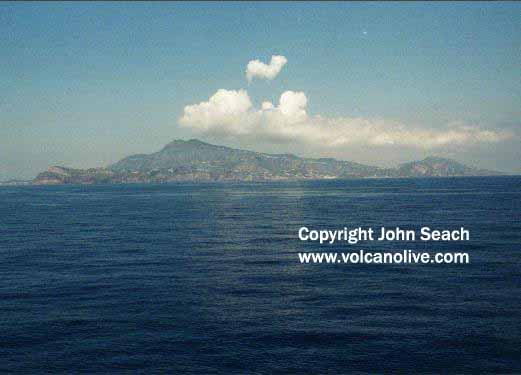Volcano Live
volcanolive.com
Ischia Volcano | John Seach

Campania, Italy
40.73 N, 13.98 E,
summit elevation 787 m
complex volcano
Ischia Island is locate off the Gulf of Napoli, 30 km WSW from Napoli. The island is the westernmost active volcano of the Campanian Plain. The Campanian Plain is a NW–SE trending depression, 5 km deep, and bordered by limestone platforms. Ischia covers and area of 46 sq km, and is the largest island in the Gulf of Napoli.

Ischia Island - John Seach
The island summit, Epomeo, was formed from uplift of ash-flow tuff (possibly erupted from Campi Flegrei), by magma intrusion at shallow depth.
Geothermal Activity on Ischia Island
The most impressive fumarolic activity is located on the southwestern
flanks of Mt. Epomeo, up to the altitude of 500 m. Thermal springs occur on Ischia island at elevations between sea-level and 200 m. Only cold springs and fumaroles occur at higher altitude. Fumaroles and springs are located mostly along faults or lineations, suggesting that they are fracture-controlled. They are also concentrated around the margin of Mt. Epomeo.
Eruptions at Ischia
Historical eruptions have been discountinuous, and occurred in the eastern part of the island. No eruptions have occurred on Ischia for 700 years, but intense seismic activity (especially in 18th and 19th centuries) as well as continuing ground deformation point to magma movements at shallow depth. A shallow magma body is located below the island, causing ground deformation. Ischia Island tilted southward by about 30 cm between 1913 and 1967.
1302 Eruption
The most recent eruption on Ischia occurred during January or February 1302, after a thousand years of inactivity. A new crater formed at Cremate and lava flowed (named Arso) to the NE coast. A phreatic or phreatomagmatic phase of the eruption was followed by the emission of large volumes of fresh pumice and ash, darkening the sky and causing ash falls to 300 km distant. Like the eruption of Vesuvius in 79 AD, the local inhabitants were taken by surprise and left possessions behind. The eruption produced a small spatter cone and a 2 km long flow.
Further reading
Selva, Jacopo, et al. "Multiple natural hazards at volcanic islands: a review for the Ischia volcano (Italy)." Journal of Applied Volcanology 8.1 (2019): 1-43.
Sbrana, A., Marianelli, P. and Pasquini, G., 2018. Volcanology of Ischia (Italy). Journal of Maps, 14(2), pp.494-503.
Paoletti, V., et al. "The Ischia volcanic island (Southern Italy): inferences from potential field data interpretation." Journal of Volcanology and Geothermal Research 179.1-2 (2009): 69-86.
Ischia Volcano Eruptions
1302, 295 AD, 145 AD?, 80 AD, 69 AD, 6 BC, 91 BC, 250 BC, 350 BC?, 470 BC?, 500 BC?